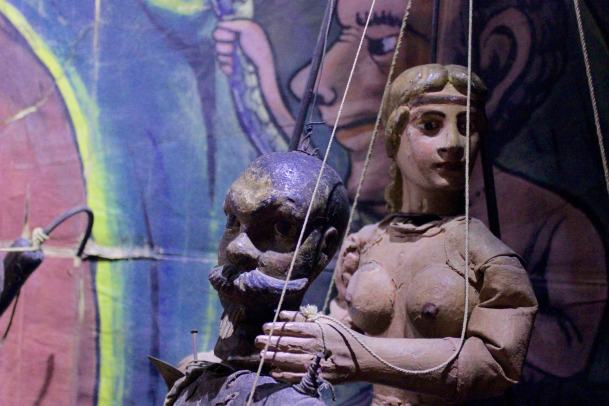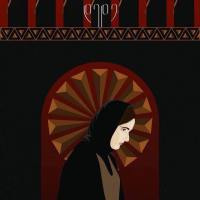Opera Dei Pupi In Palermo

A room full of knights at Il Museo internazionale delle marionette in Palermo Sicily.
My primary reason for coming to Palermo on the island of Sicily in Italy was not to see the mysterious hanging corpses of the Catacombes Dei Cappuccini (though I confess that was quite high on my list of reasons) but rather to see some other antique pendulous figures, Opera Dei Pupi, the Sicilian Marionettes. Whose lineage goes back perhaps 250 years to the late Eighteenth Century with versions being referred to in both Naples (Napoli) and Sicilia. Now stringed marionettes as we usually think of them go back much further. But the Sicilian versions developed in a very specific way that continues down to this date.

The Moon drifts by during the performance Opera dei Pupi teatro Carlo Magno
Opera dei pupi does not mean ‘puppet opera’, they certainly aren’t performing Verdi with these marionettes, then again as Enzo Mancuso pointed out, marionette isn’t the right word either. The Italians have the word marionette and they have other words for puppets too, burratini are hand/glove puppets, fantoccini are trick puppets. In fact the word for all types of puppets considered together is burratini. But pupi are the puppets that are specific to this Sicilian style. They have a couple of strings, real marionettes can have nine or more, and they also have a metal rod attached to the head and often to one hand. This is quite similar to the puppets at Toone in Brussels, whose style is derived from Sicily, although no one can quite point to exactly when and how. Possibly through a wandering puppeteer. But another feature, and this is similar to Toone as well, is the size of the pupi. They are one third scale, one third the size of a human being. And since there is wood involved, this makes the pupi quite heavy. Then there are major differences between the Toone style and the pupi, obviously the Belgians didn’t quite get the whole recipe for their pupi influenced marionettes.

The guy who turns the hand cranked player piano
One difference is that the pupi are almost always heavily armored, which, while the metal is light, adds even more to the weight, I didn’t see any women behind the scene hefting these weighty figures, unlike in Brussels. Next the pupi often perform feats that require much more mechanical invention. So both Toone puppets and Sicilian pupi will feature decapitation during a fight. But for the Toone puppets to pick up a sword or any other objects is a lovably clunky affair. The pupi on the other hand simply reach down to the scabbard pull out a sword and then have a hard clanking fight with it. And then they put it back with ease. And all of this happens gracefully, seemingly in one motion. Also not only do the pupi lose their heads, but their faces are slit in half, whole bodies sliced down the middle, legs separated from torsos, arrows launched into the knights and much more. During their plays there has to be a big battle scene. One brave character, usually Orlando, stands against all comers.

Orlando and Rinaldo face off. Notice the pile of pupi corpses!
And then there is the noise, like Palermo itself, these are loud puppet shows. One young girl brought to an evening show kept her hands over her ears from the moment she entered the theatre until about two thirds of the way into the show when she finally just gave in and went with it. And the puppeteers wears a special wooden shoe to make even more noise on the wooden stage. And other special devices are used backstage to create more sounds. And finally it is all topped off with a special hand cranked player piano device that was obviously created over a hundred years ago and gives the action a charming antique chaos as pupi clash while the actors’ voices are histrionically exaggerated with vocal quavers and taunts. And when you get a whole room full of children who laugh and cheer at every act of violence and special mechanical trick you get the full dissonant catastrophe. All in all quite a spectacle!

A siren riding a centaur from the pupi version of Ulysses. (From the International museum of puppetry in Palermo)
My first stop was at Il Museo internazionale delle marionette (the International museum of puppetry), one of the best puppet museums I’ve yet discovered. (Someday I should list the various puppet museums I’ve visited.) Naturally one assumes that they will have a very thorough display of Sicilian pupi, and they most certainly do. Along with hand burratini, featuring commedia dell’arte figures and many other classic European puppets. But beyond that they had quite a full representation of puppets from China, Japan, Southeast Asia, Indonesia, and Africa. Plus a few Modernist puppets. All in all a worthy collection complete with a pupi theatre. And an interesting selection of books for sale. Now the difficulty with the museum from my perspective was that it was difficult to communicate with the front desk staff because English is simply not well spoken in Sicily. Eventually I bought a ticket and looked to find someone who could help me. I did find a woman who spoke a bit of English. She then introduced me to Monica Campo who was fluent. They told me that I could come back the next day at noon and would be granted an interview with the director. Well that was good news. And I would certainly return.
Rosario Perricone answers a few questions for Gravity From Above.
On the following day, Monica greeted me, I had come early to set up my tripod and camera. And to get a feel for the light. Eventually I was introduced to Rosario Perricone, il direttore. Rosario was a man in his prime, several days growth of stubble, a trend down here, and obviously a very intelligent and vigorous man. When I first started Monica translated line for line. Then Rosario had another idea. He would speak for a while and she would summarize. And so he began. It was like turning on a fire hose. He spoke in lightning speed for about 15 minutes. Probably containing 40 minutes worth of any other interview I’ve done. Surprisingly I was able to follow the general tone of what he was saying. I knew enough Italian, Latin, French, Spanish, plus theatrical and puppetry words to hear a variety of concepts being addressed. When he finished I turned to Monica with a smile as if to say ‘Well?’ She smiled back. Rosario left the room for a while as I discussed the impressions I had of what he had said. Then Rosario returned and we did this a couple more times. I also got an answer to a question I’ve had for a while: What is the oldest continual puppet theatre in Europe? And the answer technically still is the Toone theatre in Brussels. But there has been a family with a longer history in Sicily, going back to the late 18th Century. (I would have to get the interview translated to tell you the name.) At one point I asked about the point of puppets in the 21st Century, when we have so many other kinds of entertainment and art mostly coming at us through screens. Uncharacteristically he struggled for his words and then carefully said a couple of sentences. We could all tell that something worthy of the subject had been said. Even Rosario asked for a copy of his statement. I won’t give my impression of it now, except to say that, yes, we do in fact need puppetry in this time. (Monica will help translate this for me later.) All in all it was an excellent interview and prepared me to see a real show of the opera dei pupi.

Warrior woman from the International museum of puppetry
One teatro dei pupi had responded to my translated messages, Opera dei Pupi teatro Carlo Magno Enzo Mancuso. I stumbled around near the docks until I came upon the teatro on a narrow side street festooned with graffiti.I had been supposed to come earlier, but that was at the exact same time as the interview the Rosario Perricone. So I had to honor my earlier commitment. That was fine. Enzo and crew were happy to have me no matter what. I attended two performances, the first an evening show, which was sparsely attended. The next morning at 10 a show packed with children between about 7 and 10 years old. The shows were similar. The audiences were not. The children howled and squealed with delight. Though their guardians shushed them, sometimes making more noise than the children in doing so.

Enzo Mancuzo of Opera dei Pupi teatro Carlo Magno
But in both cases we were treated to the legendary exploits of Orlando, who fought off the Moors near Poitiers in France around the time of Charlemagne. This was about as gleefully politically incorrect in this age of hyper-sensitivity as you could want. And as relevant. Many folks have forgotten how close the Islamic invasion was to sweeping into all of Europe. And these stories keep that fact alive. And as far as I could tell the Islamic side was treated fairly in these legends as portrayed in these Sicilian narratives. In the past the story of Orlando Furioso was done as a long continuing saga. Some versions had over 300 parts. With a heavy reliance on cliffhanger endings. But as Rosario explained to me by the 1960’s the Opera Dei Pupi was pretty much dead. People just didn’t want these old fashioned things anymore. But there was a revival ironically through left wing political sources, just as they had been behind the folk music revival in America. And one of the things that happened was that the plays became self contained. No more endless cliffhanging, no more long drawn out legends. The same stories of Orlando and Renaldo would be told. And there were many different stories. But now they resolved. Slowly also they attracted a tourist audience as well. And they were played for school children. As I witnessed.

Enzo explains in detail how the pupi work before the show for kids.
Now one of the most fascinating aspects of the children’s show was that Enzo, a swaggering burly guy capable of lifting the heavy pupi and making a lot of noise, introduced the show by explaining to the children the difference between history and legend, and about the time of Charlemagne. Now when I say that he introduced the show, please do not imagine someone getting up to talk for a few minutes and then saying ‘Okay let’s watch the show!’ Oh no. His introduction lasted easily a half an hour. And he asked the bambini questions and they asked him questions. And he poked fun at them. And they poked fun at him. All the while he went into great detail about opera dei pupi. And after the rip-roaring show he came out again and showed us many of his special effects and devices, how the swords were done, the strange sounds they made. It was absolutely fascinating. And once again I realized that how you deal with children says so much about the culture. Watch the pupi was in fact a step on the road becoming Sicilian. And in the incredible battles and over the top noise and wild language there was something deeply Sicilian in all of this. And one thing you can say, Sicily is not a society for wimps. And Orlando is incredibly furioso.

A rare tender moment for Orlando, notice the dead puppet.






Pingback: Gravity From Above: A Personal Reckoning | GRAVITY FROM ABOVE